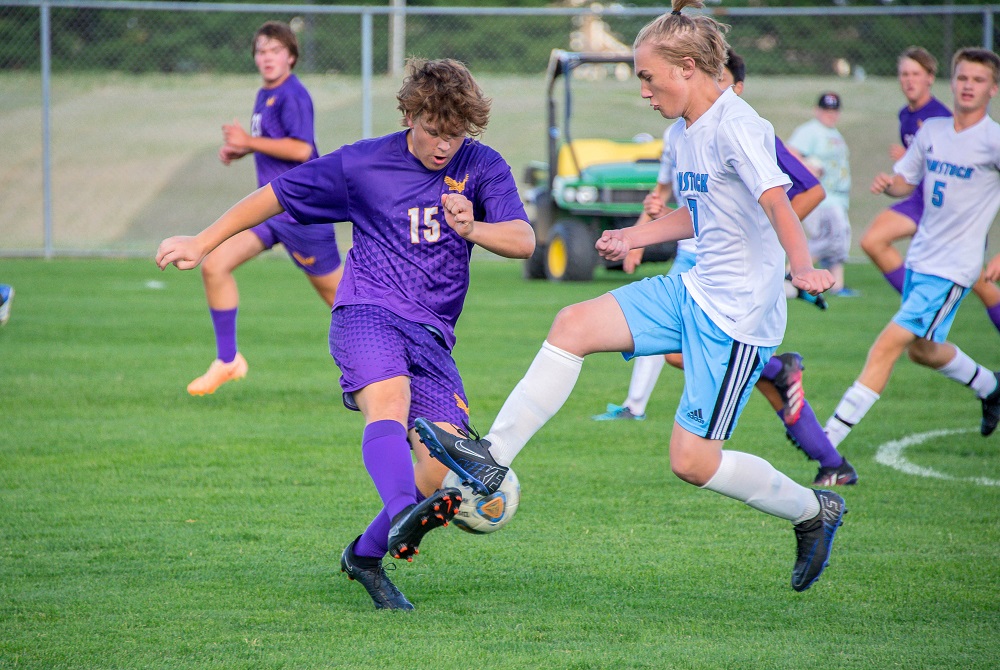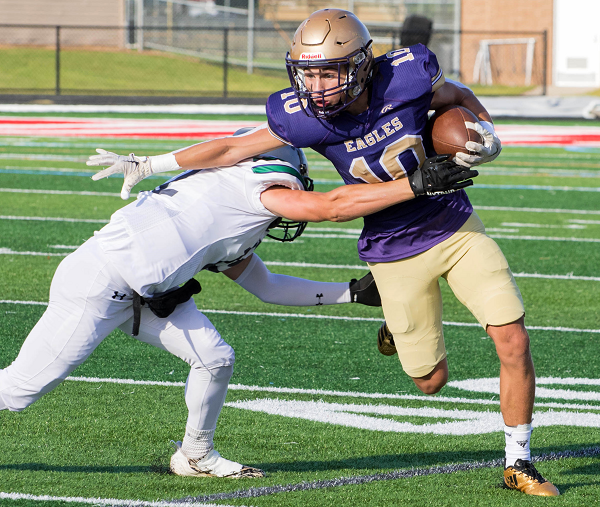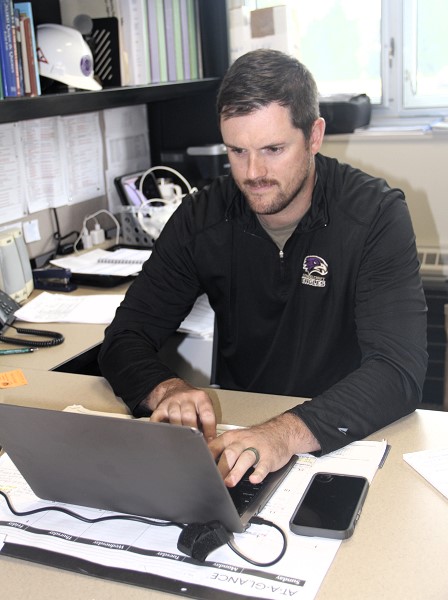
Haslett Saving Big Hits for Game Time
August 16, 2016
By Geoff Kimmerly
Second Half editor
HASLETT – The sound of cleats on pavement. He and his teammates, hand in hand, walking toward the field together minutes before kickoff. Manowar’s “Heart of Steel” ringing in their ears from a few minutes before.
 Justin Kuchnicki gave himself goose bumps Monday describing Haslett’s weekly pregame ritual, which the senior lineman will take part in again beginning Aug. 26 when the Vikings open this season against Remus Chippewa Hills.
Justin Kuchnicki gave himself goose bumps Monday describing Haslett’s weekly pregame ritual, which the senior lineman will take part in again beginning Aug. 26 when the Vikings open this season against Remus Chippewa Hills.
They’ll certainly be revved up – and especially to lay some big hits after saving them up during three weeks of non-collision practices.
Haslett has one of the most successful football programs in the Lansing area, with two trips to MHSAA championship games and 14 playoff appearances total over the last 18 seasons. The Vikings finished 6-4 a year ago against a schedule featuring four eventual playoff teams.
The program also might be the first in all of Michigan high school football to fully eliminate full-speed hitting at practice, something Haslett has moved toward over the last few seasons before longtime coach Charlie Otlewski decided to knock it out of his practice plans completely this fall in large part to keep his players healthier for when it matters most.
“It gives you the edge when it gets to game day. You practice all week and you’re not really hitting or doing anything like that, and you get to game day … and everyone’s ready to just go out there and fly around and make plays,” Kuchnicki said. “You’re not really worried about kinks and stuff in your body that you’d have from practices, so you just go out there and lay it on the line.”
Friday was the first day Michigan high school players were allowed to practice in full pads. Storms drenched mid-Michigan that afternoon, so Haslett’s first day in full gear was Monday. And from a distance, it sounded like any other full-contact practice with the normal hoots and hollers and smacking of pads.
But on closer look, it was anything but. Lineman worked against blocking dummies on a sled or teammates holding hand pads. When the offense came together to run plays, linemen blocked against overturned plastic trash barrels. On the opposite end of the field, subvarsity players worked on defensive pursuit angles but again without hitting. Under a set of uprights laid an old gymnastics mat used to soften the fall during tackling drills, which players again did against standup dummies instead of their teammates.
Reducing collisions – that is, live, game-speed, player-vs.-player hitting – remains the focus of most conversations on health and safety in football. Much of the discussion is centered on reducing concussions, and MHSAA rules changes that took effect beginning with the 2014 season limit teams to one practice per day during the preseason (when teams frequently practice twice) where collisions can take place. During the regular season, teams can have collisions during practice only two days per week.
 Otlewski – who formerly coached St. Ignace from 1990-93 before taking over at Haslett in 1994 – said his practices used to follow what could be considered a traditional after-school plan: individual position drills for an hour or more followed by 11-on-11 full contact team practice for 30-40 minutes, twice a week.
Otlewski – who formerly coached St. Ignace from 1990-93 before taking over at Haslett in 1994 – said his practices used to follow what could be considered a traditional after-school plan: individual position drills for an hour or more followed by 11-on-11 full contact team practice for 30-40 minutes, twice a week.
But a handful of reasons, chiefly the desire to avoid injuries, started his program on a different path five years ago.
“Nobody wants injuries, but you surely don’t want them in practice. Then the concussion thing started to happen. (But) we didn’t do it because of concussions; we did it because of general overall injuries,” Otlewski said.
“If we lose a guy in Thursday’s scrimmage, or next Thursday in a game, OK, that’s football. But what we don’t want to do is lose someone in practice, because that seems unnecessary.”
The initial changes Haslett began to make to practices that fall of 2011 became drastic two years later, when he and his staff went to a different practice model completely. The Vikings now break every practice into 10-minute sessions alternating between team time and position drills, so position coaches can work with players individually before and after seeing how they perform when all 11 are running plays together.
This new breakdown brought the amount of player-on-player contact at practice down significantly as much more time was dedicated to learning proper footwork, blocking and tackling techniques and other fundamentals. Players on Monday worked at 50-percent speed, at most, against teammates either in front of them and also not moving at game speed, or against others holding pads and dummies.
The last two seasons, the only full-contact session during practices came during preparation for goalline situations; Otlewski and his staff decided to eliminate those this fall as well.
“We’re OK with a certain level (of contact). But we never want to go on the ground; we always want to stay up,” he said. “We want to go fast enough so where we have to use the perfect technique to get there footwork-wise. But we’re trying to eliminate the physicality part.”
To be clear, eliminating all collisions/contact is not required by the MHSAA. And there are probably more than a few in the coaching fraternity who would think Haslett is making a massive mistake.
But the Vikings’ no-contact strategy follows a way of thinking made popular in part by coaches like Dartmouth College’s Buddy Teevens, whose team hasn’t tackled during practices in six years. The Ivy League as a whole adopted a policy of no tackling in practice for the regular season beginning this fall.
 Otlewski said teaching to tackle without contact allows his players to practice the same technique-building drills during four-player offseason workouts, his team’s no-pads summer camp and then while wearing pads during the season. His defense doesn’t face a live offense during the week, but he doesn’t think his players lose out because they can gain just as much from watching film and working on pursuit angles and recognizing formations. Same goes for his offense, which can still practice skill work and the passing game full-speed while lineman go half-speed working on footwork and blocking technique.
Otlewski said teaching to tackle without contact allows his players to practice the same technique-building drills during four-player offseason workouts, his team’s no-pads summer camp and then while wearing pads during the season. His defense doesn’t face a live offense during the week, but he doesn’t think his players lose out because they can gain just as much from watching film and working on pursuit angles and recognizing formations. Same goes for his offense, which can still practice skill work and the passing game full-speed while lineman go half-speed working on footwork and blocking technique.
And he sees 37 players on his varsity roster, with that total remaining consistent over the last many seasons – while three opponents on this year’s schedule don’t have junior varsities and a fourth won’t field a freshman team.
His players three seasons ago didn’t really like the idea of not hitting in practice at first. But they’ve since bought in. He hasn’t heard a ton from parents either way; but he taught a class on football for local moms over the winter, and they seemed to like the idea as well.
“On one hand, I’m a little apprehensive,” Otlewski said. “OK, we haven’t gone full go. Is there a difference all of a sudden when it’s live Thursday against (Grand Rapids) Christian? Are we going to be up to speed?
“I think I still worry about that a little bit. But once we get into it, it’s fine.”
Kuchnicki is just as confident. Contact doesn’t bother this guy. He’s 6-foot-6 and in the neighborhood of 320 pounds. Sure, he’d love to have one contact practice this year so he and his teammates can back up some of the trash-talking they do to each other on the field.
But he’s fine with saving his biggest hits for opponents – and especially those who might think Haslett won’t be prepared for a physical game.
“They’d probably think we’re soft,” Kuchnicki said. “But when it comes game day, they change their minds instantly. I’ll tell you that.”
 Geoff Kimmerly joined the MHSAA as its Media & Content Coordinator in Sept. 2011 after 12 years as Prep Sports Editor of the Lansing State Journal. He has served as Editor of Second Half since its creation in Jan. 2012. Contact him at [email protected] with story ideas for the Barry, Eaton, Ingham, Livingston, Ionia, Clinton, Shiawassee, Gratiot, Isabella, Clare and Montcalm counties.
Geoff Kimmerly joined the MHSAA as its Media & Content Coordinator in Sept. 2011 after 12 years as Prep Sports Editor of the Lansing State Journal. He has served as Editor of Second Half since its creation in Jan. 2012. Contact him at [email protected] with story ideas for the Barry, Eaton, Ingham, Livingston, Ionia, Clinton, Shiawassee, Gratiot, Isabella, Clare and Montcalm counties.
PHOTOS: (Top) Haslett lineman work on blocking during Monday's practice. (Middle) Vikings coach Charlie Otlewski instructs his players on one of the team's blocking schemes. (Below) Backs work on the option with barrels serving as the defensive front.

Working Together, with Neighbor's Help, Schoolcraft Teams Making Selves at 'Home'
By
Pam Shebest
Special for MHSAA.com
September 19, 2023
SCHOOLCRAFT — If it is a home game for the Schoolcraft football team, head over to Vicksburg.
 If it is soccer, go to Schoolcraft’s baseball field.
If it is soccer, go to Schoolcraft’s baseball field.
Things are a bit jumbled in the sports world for the Eagles this season.
With a new football field under construction and a new elementary school built on the site of the former practice fields, the two teams have been a bit displaced.
“Along with our football field, we had three practice fields that were utilized by a lot of our youth programs, Rocket football, youth soccer and our soccer and football programs,” Schoolcraft athletic director Bryan Applin said. “It’s taken a lot of understanding and flexibility from our coaches, players and our community to make it work out, and it has.”
Meanwhile, all four Eagles home football games will be played at Vicksburg High School.
If Vicksburg is home on a Friday, then the Eagles will play Saturday, including their Homecoming game this Saturday against Galesburg-Augusta.
The Eagles won their only “home” game so far, 33-14 against Kalamazoo United, and take a 3-1 record into Saturday’s contest.
The soccer team gave up its field to the football team for practices and has been practicing and playing their matches in the outfield of the baseball stadium.
For the soccer team, “It’s kind of an upgrade,” Applin said. “The soccer field they traditionally play on, they don’t have a scoreboard, they don’t have a bathroom facility, so we’ve been able to use the (baseball) scoreboard, the PA system, open up the bathroom building.
 “The goal at some point is to give soccer a home, and we’re very, very excited about that.”
“The goal at some point is to give soccer a home, and we’re very, very excited about that.”
This year definitely has been challenging for the first-year AD, who credits Vicksburg athletic director Mike Roy with being a tremendous help.
“Mike Roy has been nothing but accommodating to us,” Applin said. “He’s been super helpful to me stepping in and assuming this scenario.
“The communities are so close, it almost feels like home for us.”
Roy said Jeff Clark, former Schoolcraft AD, reached out once the bond was passed for the new stadium last year.
“We had to make small accommodations as did Schoolcraft to make the schedules work,” Roy said. “By moving (Schoolcraft’s) games to Saturday, Vicksburg had to work with our Rocket football organization to make sure games were completed” before the Eagles varsity games.
Schoolcraft football coach Nathan Ferency said his team has been “rolling with the punches.
“These guys don’t care where it’s at; they just want to play football. We’re all taking care of each other. What a great place to be when everybody works together.”
When Jake Bailey heard the team would be playing at Vicksburg, “That got me excited,” the junior offensive tackle said. “They’ve got a really nice facility. I know the school will come out to support us no matter where we are, but it’s definitely different.
“Good thing we don’t play Vicksburg, although it would be fun because it would be both our home fields. The new facilities and being back at our home field at Roy Davis (Field next year) will be really fun.”
Vicksburg is Division 4, while Schoolcraft is Division 7.
 The soccer team was “just being a team player” in giving up its own field for football practice, second-year head coach Jeremy Mutchler said.
The soccer team was “just being a team player” in giving up its own field for football practice, second-year head coach Jeremy Mutchler said.
“For the soccer team to be a team player and get behind the football team will help the community get behind the soccer team as well,” he added.
The biggest drawback is that part of the current field includes a piece of the baseball infield.
“The only odd thing is it is a smaller field, still regulation size, but smaller,” Mutchler said. “Part of the field is in the diamond, so we have to play in the dirt and it gets tricky, especially when you’re trying to throw it in or just play down the line.”
The move has cost the team a few home games.
“At the beginning of the year, we allowed schools, if they didn’t want to play here, we would go to their house,” Mutchler said. “We had to go to a few schools we would have played at home.”
Maintenance supervisor Eric McGehee was instrumental in preparing the field.
“He laid out exactly the parameters, so I was able to send that to all the ADs that were going to visit to give them an opportunity to decide whether that’s something they wanted to help us out for our home games,” Applin said. “A lot of schools were more than willing to come and play us to give our boys some home games. A couple wanted to be cautious and play on a more traditional surface, and we were able to make those arrangements as well.”
In only its second year as a varsity sport, the boys soccer team is still finding its identity, posting a 2-5 record so far.
 “We’re a very young team,” Mutchler said. “All juniors and freshmen. This is the juniors' second regular season. It’s all been a learning phase with maturity and sportsmanship.”
“We’re a very young team,” Mutchler said. “All juniors and freshmen. This is the juniors' second regular season. It’s all been a learning phase with maturity and sportsmanship.”
Junior captain Jack Curtis said he was a bit “bummed out” when he heard the team would move to the baseball field.
“The first practice, I drove over to our practice field,” he said. “No one was there.
“I drove over to the high school and saw everyone practicing (at the baseball field). I didn’t think a soccer field could fit on a baseball field.”
Curtis said in spite of the temporary move, “I’m just glad we can have some home games this year on Schoolcraft soil.”
As for Applin, he spent much of his career coaching basketball at both the high school and college levels and most recently worked as a salesman for Zeigler. His wife, Meredith, is an assistant coach for Western Michigan University’s women’s basketball team.
Ferency is appreciative of the work Clark and Applin have done to make this season’s changes relatively seamless.
“I’d like to highlight how great our athletic department is,” he said. “It takes a lot of moving pieces and parts to move people around and have a space for everybody.
“I’m really proud of our athletic department and all our coaches and kids for just rolling with the punches.”
 Pam Shebest served as a sportswriter at the Kalamazoo Gazette from 1985-2009 after 11 years part-time with the Gazette while teaching French and English at White Pigeon High School. She can be reached at [email protected] with story ideas for Calhoun, Kalamazoo and Van Buren counties.
Pam Shebest served as a sportswriter at the Kalamazoo Gazette from 1985-2009 after 11 years part-time with the Gazette while teaching French and English at White Pigeon High School. She can be reached at [email protected] with story ideas for Calhoun, Kalamazoo and Van Buren counties.
PHOTOS (Top) Schoolcraft’s varsity boys soccer team, including Nyan Wonders (15), faces Comstock this season on its field in the outfield of the baseball stadium. (2) Schoolcraft’s Kolby Lloyd (10) works to break away from a tackler during a “home” game played at Vicksburg this fall. (3) Clockwise, from top left: Schoolcraft football coach Nathan Ferency, Schoolcraft boys soccer coach Jeremy Mutchler, soccer player Jack Curtis and football player Jake Bailey. (4) Schoolcraft athletic director Bryan Applin has taken over the maneuvering of the teams’ home sites during his first year on the job. (Action photos by Stephanie Blentlinger/Lingering Memories Photography. Headshots and Applin photo by Pam Shebest.)

